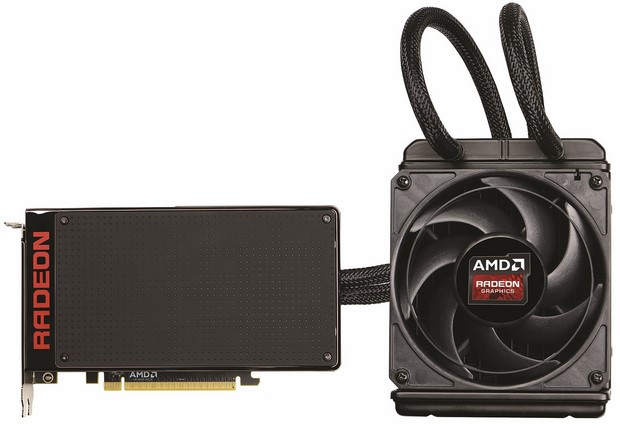AMD Radeon R9 Fury X Review: Fiji And HBM Put To The Test
Radeon R9 Fury X Card
In addition to the new GPU, AMD has incorporated a number of new design approaches (at least for AMD) into the Radeon R9 Fury X. There was obviously a clear effort within the company to improve the Fury X’s design language over previous generation Radeons, and it shows.
As we’ve mentioned, the Radeon R9 Fury X features a nice, short, 7.5” PCB, which results in a compact overall design—save for the radiator and fan assembly, that is. The shroud and bracing assembly on the Fury X also features die-cast aluminum construction with high-quality, black-nickel plating, which looks really good up close. The front, rear and top panels on the card also have a soft-touch texture that’s a bit of a departure from older Radeons. All told, when handling the card, is simply feels of higher quality than previous-gen Radeons that packed a ton of plastic. We’re told AMD is also toying with the idea of releasing the CAD data for the front panel should enthusiasts want to 3D print their own custom panels.
There’s a lighted ‘Radeon’ logo along the top edge of the card as well, which adds a bit of flair, along with an LED array AMD calls a “GPU Tach” that resides just above the power connectors. A single green LED indicates that the card is in ZeroCore power mode, while the rest of the LEDs flicker dynamically to indicate the load being placed on the GPU. The color of the LEDs is also user configurable to red or blue.
Outputs on the Radeon R9 Fury X consist of a trio of full-sized DisplayPorts and a single HDMI output, all four of which can be used simultaneously. In fact, with a DP hub connected, the Fury X can power up to 6 independent displays in an AMD Eyefinity configuration. We should point out, however, that the HDMI port is not HDMI 2.0 compliant, so users thinking of slapping a Fury into a small form factor HTPC and connect it to a 4K display may not be too pleased.
An added benefit of the Radeon R9 Fury X's liquid-cooling setup is that virtually all of the heat produced by the card is pumped out of a system through the radiator assembly. We're sure some folks aren't took keen on mounting a radiator in their system and would prefer an air-cooled R9 Fury, especially with multi-card configurations, but there are merits to the design.
And although we won't be going in-depth on these features in this article, we should also mention the the Radeon R9 Fury X offers full support for AMD's FreeSync adaptive refresh rate technology and Virtual Super Resolution. You can read more about those technologies right here. There's also a new feature being introduced with the latest Fury X driver that gives users the ability to limit framerates, which can also save a significant amount of power.
And although we won't be going in-depth on these features in this article, we should also mention the the Radeon R9 Fury X offers full support for AMD's FreeSync adaptive refresh rate technology and Virtual Super Resolution. You can read more about those technologies right here. There's also a new feature being introduced with the latest Fury X driver that gives users the ability to limit framerates, which can also save a significant amount of power.










